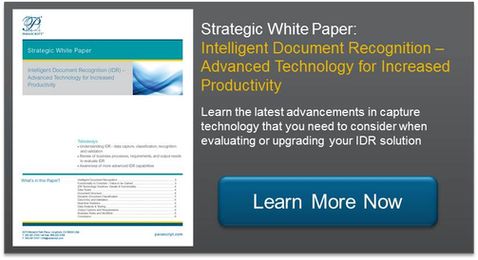More and more hospitals and insurers are looking to move medical records, claims and enrollment applications online. However, due to doctors and patients limited access to computers and the ease of applying pen to paper, healthcare organizations are still very reliant on paper forms.
The many steps involved in processing healthcare documents, from completing information on the form to manually keying in the information, result in a surprisingly large amount of errors. These errors cost healthcare companies a tremendous amount of time and money. Some common errors include:
Address information Companies who rely on manual keyers to enter address information from forms have limited resources available to validate the address and can experience high levels of returned mail. This ultimately results in lost time and money to correct the address, re-mail the information and wait for payment
Diagnosis number Medical professionals must use a diagnosis code number to indicate the patients diagnosis/condition. If manual keyers enter an incorrect digit in the coded disease field it can mean the difference between a sore throat and cancer, not to mention a possible denial of insurance, larger premiums and other confusion with a patients medical records
Policy code A wrong digit on the policy code can result in lost claims revenue for providers and insurers, returned cards, increased mailing and re-mailing costs and valuable time wasted correcting the information
Names Manual keyers have been known to switch the order of first and last names. This common mistake requires time and money to correct and, even worse, can lead to confusion in identity/matching of records which can have harmful consequences and results in poor customer service
It is estimated that companies that manually key information from healthcare forms may have an error rate as high as 20 percent. These errors result in hours of lost time and revenue from unprocessed claims, misdirected correspondence, reprocessing incorrect and returned information, re-sending corrected materials, etc.
Why are Error Rates so High?
Medical forms, such as CMS-1450 and 1500 forms are extremely complex documents with numerous types of fields. Traditionally, companies have relied on manual processing, which is time-consuming, costly and prone to errors. A single operator can cost up to $50,000 in salary and overhead, plus training and administration.
Automated data recognition can eliminate many of the errors mentioned above and offer a more cost-effective solution to data entry. However, in the past, the handful of automated form processing solutions available, were limited in their data capture capabilities and resulted in disappointing results for insurers and health institutions. Even today, some software cannot read CMS 1450 and 1500 forms if they are completed in different or multiple fonts or include cursive handwriting. Some can only accurately read forms if they follow an exact layout. Text that may reside outside of boxes and predetermined spaces is often unreadable. This poses a serious limitation for healthcare organizations, given the fact that claim forms have boxes that run close together and information is often printed outside of them. Knowing what to look for in an automated solution is critical to achieve success and ensure that information is captured accurately.
Getting it Right the First Time
Good form processing starts with the form. Using advanced recognition technologies is one way companies can improve the quality of data they are capturing. Some of the current recognition systems offer checks and balances that can prevent discrepancies in data entry and coding as well as reduce the costs of manual processing.
Automated data entry helps insurers process claims and enrollment forms faster, more accurately and cost-effectively by using special algorithms that can verify information such as a zip code against an address field. These processes help ensure data is correct. In addition, information that is not recognized can be flagged and sent to a keyer for verification. Finally, quality control measures can be built in throughout the process, including instituting double or triple keying centers, putting additional auditing systems in place and randomly pulling files for quality checks. Companies should look for a system that:
Combines OCR (machine print), ICR (constrained and unconstrained handprint, including cursive) to recognize all character types
Uses field registration (versus form registration) to account for shifts in placement of fields and information printed outside of boxes
Applies business rules before and after recognition, as well as after verification (manual data entry) for more powerful processing and more accurate information
Includes multiple form preprocessing and recognition techniques, such as whole-word and whole-phrase recognition, dynamic vocabularies, confidence values, address validation and context sensitivity
Allows users to adjust confidence levels for each field to ensure the highest accuracy for the most critical fields
Enables the user to define the format of answers, describe relationships between fields and set guidelines for field processing
As healthcare organizations aim to improve margins and operate faster, better and smarter, they will look to processes that enhance the quality of their most valuable resource information. Advanced capture reduces tedious manual entry and eliminates the layer of interpretation prone to human error. Automated recognition enables organizations to improve the quality of their data, free up keyers and processors for more critical tasks and shift the focus to improving customer service and accelerating payment processing.
For the latest in capture technology, download our white paper Intelligent Document Recognition – Advanced Technology for Increased Productivity.

